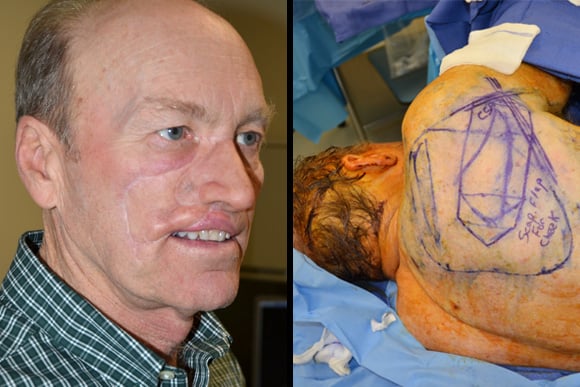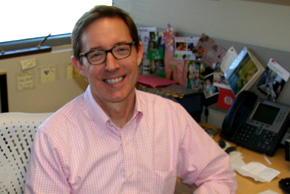 Nic Patrick's reconstructed face was produced from the skin off his back shoulder.
Nic Patrick's reconstructed face was produced from the skin off his back shoulder.
In June 2013, Nic Patrick toted an irrigation shovel on an early-morning ramble with his dog to water the meadows on his Wyoming ranch. With little warning, he found himself in a situation that is the stuff of nightmares.
Hearing barking, Patrick moved forward to stop what he thought was one of his dog’s “epic fights” with a raccoon. As he rounded a hill, yelling at the dog to stop, he came face to face with a female grizzly bear and her two cubs.
In a matter of two or three seconds, the bear was on Patrick. He swung the shovel and smacked her in the face without much effect. His face was exposed, and the bear bit off a large portion of the right side, ravaging the area between his eye and mouth and taking off his entire nose. She then dragged him by his left knee about 20 feet. Patrick turned onto his stomach, hoping that he could outlast her protective fury. The bear finally left.
His upper lip dangling, Patrick pulled out his cell phone to call for help, but discovered he was in a pocket without service. In a matter of moments, he had bigger problems. He heard the bear running back toward him.
“She tied into me again,” he recalled, biting the back of his head and tearing through his vest before she gathered the cubs and lumbered off.
Patrick walked back to his home near Cody – about a quarter mile – to begin a remarkable story of recovery from the horrific injury. When he recounted the incident in a phone interview late last month, he expressed his gratitude to Frederic Deleyiannis, MD, the University of Colorado Hospital and Children’s Hospital Colorado surgeon who performed a series of complex facial reconstructive surgeries that successfully concluded in February.
No blame for bear
Completely absent from Patrick is any rancor toward the bear, who he believes continues to roam the area where she attacked him.
In the instant that he surprised the sow, he remembers feeling “disappointment that I had blundered into this situation and set myself up – and that it would reflect poorly on bears."
However understandable her motherly response, she wreaked tremendous damage on Patrick, whose face looked like it had received a shotgun blast. When he got home, he threw a rag over his face to conceal the wound from his granddaughter. Wife Joyce coordinated with their daughter to get Patrick to the hospital in Cody.
 From there he was air-lifted to UCH, where Deleyiannis performed an initial surgery to clean the tissue in and around the wound and fix facial fractures with titanium screws and a plate. Patrick awoke from that surgery with no idea where he was and unable to talk because of a tracheal tube.
From there he was air-lifted to UCH, where Deleyiannis performed an initial surgery to clean the tissue in and around the wound and fix facial fractures with titanium screws and a plate. Patrick awoke from that surgery with no idea where he was and unable to talk because of a tracheal tube.
After the initial procedure, Deleyiannis discussed with Patrick a plan to reconstruct the damage the bear had done. The challenge was that she had left little for Deleyiannis to build on.
“The bear had removed his nose and cheek. They were gone,” Deleyiannis said.
Build from the back
The solution? Find material elsewhere. “With defects like these, we try to reconstruct the area with tissue harvested from another part of the body,” Deleyiannis said.
A week after the first surgery, Deleyiannis undertook a second. Following an outline drawn on Patrick’s back that provided a roadmap of the blood supply, he harvested a flap of skin, fat, fascia, veins, and arteries from the area around Patrick’s shoulder blade. He then transferred the scapular flap – the living clay he would use to reconstruct the right side of Patrick’s face – to the wounded area. Deleyiannis performed hours of microvascular surgery to connect the flap tissue to the blood supply in Patrick’s hollowed-out right cheek.
To replace his nose, Patrick and Deleyiannis decided on a prosthetic attached with screws and magnets implanted in his upper jaw.
The June 2013 scapular tissue transfer laid the groundwork for another eight one- to two-hour procedures Deleyiannis performed to thin and contour the cheek tissue to restore Patrick’s natural appearance to the greatest extent possible. The surgeries also gradually opened the nasal airway over which the prosthetic nose fits. Patrick said he doesn’t breathe as well as he did before the attack, but the problem isn’t disabling.
A long line running from the inside corner of his right eye to the corner of his mouth on the same side is a reminder of the attack, but it’s also a sign of Patrick’s determination to overcome a devastating injury.
“About five surgeries in, I told Dr. D. that we’ve spent a lot of quality time together,” Patrick said, “but I was only conscious for about 2 percent of it.”
Starting again
Maintaining a sense of humor remains an important part of his recovery, Patrick said. While describing the habits of the grizzlies that live near his home, he reflected that if he knew so much about them he’d still have his nose. Now 66, he also worked hard to keep himself in shape between surgeries to improve his chances for a good outcome. Rather than dwelling on the one-sided battle with the bear, Patrick spends his time irrigating, growing hay, and rebuilding the house on the ranch where he was born and raised.
Blame and regret aren’t part of the recovery equation. “I went through the stages that happen when you lose someone,” Patrick said. “I went through a couple of hours of, ‘Why me?’” After watching an inspirational video a psychologist left with him in the hospital, however, Patrick decided to focus on all the things he still can do. He and Joyce – whom he says saved his life – continue to support one another in recovering from the trauma, he said.
He credits Deleyiannis and the hospital for restoring his appearance and his health. “I was so lucky to get Dr. D.,” Patrick said. “He did an incredible job. I can do anything I did before.”
Published April 9, 2015
Contact tyler.smith@uchealth.org




